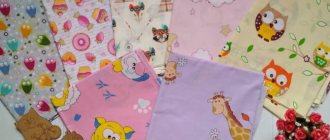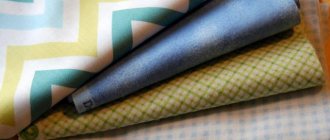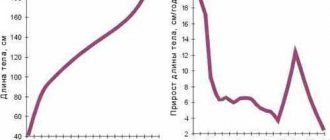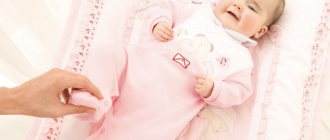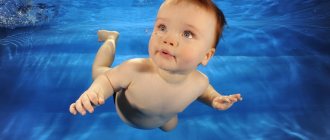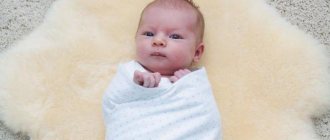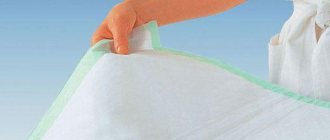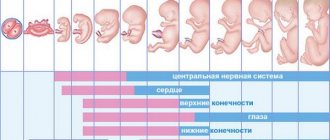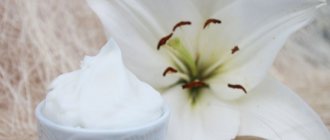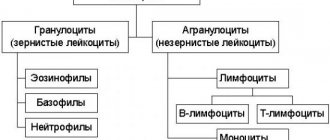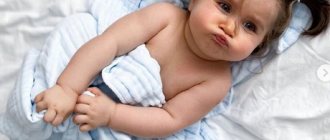Before purchasing diapers for the maternity hospital and home for the baby or choosing the material for sewing them yourself, you need to familiarize yourself with the main points of using these household items. First of all, you need to establish what size diapers for a newborn can be, in what cases certain dimensions are used.
It is equally important to decide on the material from which the products will be made. And if you plan to sew them yourself, then this factor will also affect the process of creating things necessary in everyday life. All this will help you understand how many pieces of certain models need to be prepared so that you don’t have to buy more of them urgently.
Why stock up on diapers if you have diapers?
Despite the fact that modern mothers actively use diapers to keep their baby dry and clean, it is better to stock up on diapers as well. You must take a few pieces with you to the maternity hospital, and even at home there are uses for fabric sheets. If just a few years ago swaddling was one of the conditions for proper baby care and was used until at least 3-4 months, today parents can decide for themselves whether to use this technique. But practice shows that only a few refuse it.
Today, a baby diaper can be used not only as clothing. At home it is used in different ways:
- Depending on what material the product is made of, it can retain the heat of a child’s body without allowing it to overheat or become too cold.
- If the baby needs to be calmed, then you just need to swaddle him tightly. He will fall asleep faster, his sleep will not be interrupted due to twitching of his arms or legs.
- The fabrics used for sewing diapers (including knitted ones) are easy and quick to wash. This allows you to guarantee the child cleanliness and the necessary degree of comfort.
- The fastest and easiest way to dress your baby is with a diaper.
In addition to all of the above, diapers can be taken for a walk as a replacement for soiled clothes, placed under the baby in a crib or on a changing table, used during feeding and when regurgitating.
Features of swaddling products
If you agree that a diaper is the most comfortable garment for a baby, then you will most likely have a question about how to choose the right product and how not to go wrong with the fabric. In the article we will give you a comprehensive answer about which diapers you should give preference to and what they are intended for.
Many mothers have noticed the fact that swaddling is the best choice for babies, so let’s identify the advantages of a baby product:
- easy to wash, comfortable for the child;
- heat-regulating diapers will prevent the baby from overheating or freezing;
- calms the baby, he almost immediately closes his eyes and falls asleep when swaddling;
- speed of dressing;
- helps with feeding, because children often spit up;
- easily replaces a sheet in a crib or on a changing table;
- indispensable when you are walking with a baby;
- The baby sleeps much better in a diaper.
Various materials are used to make diapers.
- Calico. Mothers use a product made from chintz when planning a walk with their baby, both in winter and summer. The diapers are made from 100% cotton.
- Flannel. Swaddles are perfect for winter weather - they protect the baby from the cold, and after bathing they serve as a blanket.
- Knitwear. Knitted products are suitable for an active child, they are elastic, giving him the space for movement that he so needs.
We should also highlight an improved version of the diaper - an envelope. 30 seconds is enough for swaddling. The diaper resembles a cocoon - the baby's legs are free, and the arms are swaddled and secured with Velcro. Convenient, and from birth they will become indispensable.
They are also disposable and reusable.
- Disposable. For travel, diapers of this type are what you need. They are moisture-wicking and multi-layered. The convenience lies in the fact that there is no need to wash them, they are simply thrown away and replaced.
Reusable. There are two types: absorbent and waterproof. Absorbent ones quickly absorb liquid, while waterproof ones, on the contrary, do not absorb, holding the liquid on the surface - they successfully replace oilcloth. Such options replace not one product, but two at once: a diaper and an oilcloth.
Sizes of diapers and features of their use
Contrary to popular belief, there is not one standard diaper size, but four. The dimensions of the products affect the way they are used:
- 80*95 cm. The smallest option, which is not intended for swaddling. It is better to use them during hygiene procedures or use them as a lining.
- 95*100 cm. Average size of products that will definitely come in handy in the first month of a baby’s life. They can be taken to the maternity hospital and used for swaddling after discharge; the size should be enough. In addition, hand-sewn models are very good as bedding.
Tip: Diapers of all standard sizes should be available in both thin and thick fabrics, even insulated fabrics. At the same time, thin ones are usually placed under warm products, which will adhere directly to the body, so insulated models can be made smaller, and they will be enough anyway.
- 110*110 cm. Large diapers, which are usually used as sheets after the baby is 3-4 months old.
- 120*120 cm. The maximum size, which is valued for its versatility. It can be used both for its intended purpose (children from such fabrics do not grow up for a long time) and as bedding. True, before you sew them yourself or buy everything in a row, you need to take into account that washing and ironing them is quite troublesome.
Before sewing diapers of the given sizes, you need to decide on the material. A few decades ago, products were either chintz or flannel. Today, the range of materials has grown to impressive sizes.
Useful tips
Young parents are interested in how to properly use children's products. Experts give some simple tips to help you get through this difficult and wonderful period.
- always keep children's things in sterile conditions;
- if you notice your baby's anxiety, change his diaper;
- wash the product with a small amount of powder;
- refuse diapers if your baby is allergic to them;
- if washing the product takes a long time, then you can easily use disposable diapers;
- bright diapers attract the baby’s attention, but they can have a bad effect on the development of his vision, and can also cause allergies due to dyes;
- choose a medium-sized product, and small and large ones are usually bought individually;
- It’s better to stock up on diapers for any time of year;
- in order for the fabric to wash better, it is first washed with soap, and only after that it is sent to the washing machine;
- The baby is usually swaddled until one and a half months, and after that only at night.
What fabrics should diapers for newborns be made of?
Not every fabric is suitable for a diaper. First of all, the material should be natural, preferably non-fading. Otherwise, you will need to buy or add a few more pieces after each wash.
Today the following products are especially popular:
- Calico. Products made from the finest cotton, soft and pleasant to the touch. Mom should definitely have several pieces not only for the summer, but also for the spring and autumn months, if the room is well heated. Even in the cold season they will come in handy; they will need to be placed under warm flannel or flannelette to maintain hygiene standards. In addition, they are used as a lining in the crib, and they are used to wipe babies after hygiene procedures.
- Flannel. Flannelette models also belong to this group. Both of them are much denser and warmer than calico. They absorb moisture well and at the same time continue to retain heat, so they can be used as a replacement for diapers. They are widely used in the daily life of a baby. Depending on the season and environmental conditions, they are useful for swaddling, covering, and wiping the baby. Flannel fabrics will serve as a sheet in a crib or stroller.
- Knitted. Today this is one of the most popular types of products, despite the fact that they are not used so often for their intended purpose. Knitted diapers are stretchy fabrics that are soft, hug the baby's body tightly, but do not tighten it. They are convenient to take to the maternity hospital and generally use until you have developed the necessary skills for swaddling a toddler. On hot days, knitwear can be used without a calico lining. Today, more and more often, manufacturers offer products in the form of cocoons and Velcro envelopes.
- Disposable. Ideal for a trip to the hospital or travel. Regardless of what material the model is made of, it will not allow moisture to pass through, while absorbing the baby’s secretions. This is ensured by the multi-layer structure. After use, you should not try to wash the product; it is better to throw it away.
- Reusable. Mothers are advised to buy at least a few items that can make caring for their baby easier and avoid using oilcloth. They can be placed on a changing table, in a crib or stroller without the risk of damage to the products.
If desired, it is fashionable to make all of the listed products with your own hands. You just need to know how to properly handle the fabric, and how many diapers a newborn needs at one or another stage of his life.
How to choose?
Let's look at what you should pay attention to when choosing a baby diaper.
- Quality . Try stretching the fabric - if it tears, then it is a bad product. You need to choose durable fabric, this guarantees quality and reliability for the baby.
- Smells. Baby cloth diapers should be odorless and soft to the touch. If you notice a suspicious smell, it is better to refuse to purchase such a product.
- Absorption. Another important part in the choice is that the diaper should be “breathable”, but at the same time absorb moisture.
- Edge processing. Pay attention to the processing of the edges - it should not be done with tight seams, as this can lead to chafing of children's delicate skin.
- Textile. Don't buy synthetic diapers. The fabric for a children's product should be flannel, calico, linen or knitted. Give preference to environmentally friendly natural fabrics.
How many diapers do you need to prepare for an infant?
While knitted diapers are more of a luxury item than a necessity, simpler fabric products are indispensable.
- To the maternity hospital you need to take 3 pieces (light, dense and reusable) or several disposable ones.
- To cover the stroller, crib and changing table - 2-3 pieces for each device.
- You need to add another 5-6 pieces if the baby needs to be swaddled.
It turns out that you need to take or sew from 15 to 20 diapers. You will have to decide on the sizes yourself, depending on the season, the size of the baby, and the purpose of the products.
How to swaddle correctly?
By following these simple rules, you will learn how to swaddle your baby quickly and easily.
- So, you have chosen a diaper. Place the child on it, but so that the edge of the fabric on the left is smaller.
- The baby's head should be positioned above the edge of the fabric.
- First, we place the baby’s left arm on the chest, and wrap the end of one fabric under the baby’s back. We do the same with the right handle, wrapping the edge of the fabric under the back.
- Spread the corners of the fabric from the bottom, covering the edge of the baby's chest. Place the right corner under the backrest and the left corner over the baby’s right shoulder. We tuck a small corner into the fold of the baby’s chest.
When choosing diapers, it is important to consider everything: what season you are buying them for, sizes, fabric, quantity. Having acquired everything you need in advance, after returning from the maternity hospital you will be solely caring for the baby, and not running around the shops looking for a changing product.
To prevent this from happening, be as careful as possible when choosing diapers.
You can learn interesting information about another diaper fabric from the following video.
What do you need to know to sew diapers yourself?
Considering the fact that a diaper is the simplest piece of fabric, making it with your own hands is not so difficult (if we don’t talk about knitted or multi-layered products). We sew diapers from natural fabric, taking into account the characteristics of the material. To begin with, we simply cut the material into the required pieces, after which we process the edges in one of the following ways: bend and stitch, stitch with a zigzag, of course, the best-looking edge will be the overlocked edge. The main thing is that the edges remain soft, do not fray and do not irritate the baby’s skin.
EXAMPLES OF GAMES AND EXERCISES TO DEVELOP INTELLIGENCE IN CHILDREN
MARIA MONTESSORI'S EARLY CHILD DEVELOPMENT METHOD
Replies: 3
I assume it's made of chintz, because... they are short-lived and tear quickly, especially if they are often machine washed at high temperatures.
Made of cotton (cotton fabric). Thick diapers are made from flannelette.
Thin baby diapers can be made from chintz or calico. Chintz is usually softer than calico and cheaper, so diapers are often made from it. But besides what kind of fabric, the density of the fabric is also important; at low density, calico is also very soft.
Diapers are just as useful a piece of clothing for a newborn as baby onesies and little ones. Even after purchasing diapers, a new mother should always have a stack of diapers.
The debate about the need for swaddling has already subsided. Most pediatricians recommend swaddling the baby in the first month or two before going to bed, but not tightly, but to give more room to the arms and legs. In the article you will find answers to many questions about an important item of clothing for a newborn, and you will learn how to sew diapers yourself.
How many diapers will you need?
Even when using diapers, you cannot do without a specially prepared cloth for your baby. Mothers agree with the popular wisdom: “You can never have too many diapers.”
Have you decided to use diapers to a minimum? Be sure to prepare 45–50 diapers (20–25 thin ones, made of chintz, plus the same number of thicker ones, made of flannel). Mothers buying diapers for babies will also need diapers: 30 pieces are enough.
Where do these numbers come from? In the first months of life, the baby often needs diapers not only during sleep.
How to determine children's shoe size in centimeters? See table of values.
What to give for the birth of a boy? Original gift ideas at this address.
Please note important points:
- During the first month, the newborn urinates 15–20 times per day and walks several times. You will have to change up to 25 pieces per day. Remember that they need to be washed, dried, ironed, which means you will need at least 5-7 pieces to replace dirty ones;
- the diaper is placed on the changing table - 3 pieces are enough for the day;
- When bathing a newborn, you also need one flannel diaper. After washing, also blot your butt and legs with a clean diaper. For these purposes, you need another 5–6 canvases per day;
- put a diaper in the crib if you are using oilcloth. Sometimes a cushion is made from diapers to prevent the baby from turning over on one side or the other due to orthopedic pathologies. Plus another 5-7 diapers;
- For a walk, also take four chintz fabrics in the summer, and two flannel ones in the winter;
- Considering the active use of diapers, it is easy to explain the number of 50 pieces for the first time after the birth of the baby.
How to sew it yourself
You already know what size diapers are needed for a baby. Before purchasing a piece of fabric, be sure to do the following:
- measure the height and weight of the baby. Have you decided to make a useful wardrobe item before the baby is born? Focus on the average weight and height of newborns, sew diapers measuring 120x120 cm: at the birth of a large child (4 kg, height 54–56 cm), diapers 85x90 cm will be small;
- think about how many light and warm diapers you will need. You shouldn’t take extra fabric, but buying a cut “butt” is also undesirable;
- choose a material with a pleasant, not very large pattern. Tones - soft, pastel, bright prints are unacceptable;
- Check the price per meter, take the required amount with you. Calculate how many diapers you will get with a fabric width of 120 or 80–90 cm;
- Be sure to buy a spool of thread for sewing edges.
Step by step:
- even a novice seamstress can easily sew fabric for a baby;
- buy fabric or pick up unnecessary sheets, which will also make soft diapers;
- Be sure to wash the new cut at 60 degrees. Without this operation, the diapers will “shrink” after the first wash of the finished product;
- dry and iron the material. Lay the fabric out on a flat surface and mark with a centimeter. You can draw lines with a simple pencil or soap;
- cut the fabric along the marked lines, finish the edges with a zigzag stitch or overlock;
- did you get the cut from the store? Decorate only the bottom and top: the sides are processed at the factory, the threads will not come off. If the diapers are made from old sheets, decorate all four sides;
- If you don’t have a sewing machine, finish the edges with a regular overlock stitch. The operation takes some time. This method is suitable for the expectant mother: after the baby is born, there will not be a free minute for this type of diaper design;
- never fold the edges of the fabric: any folds, too dense areas interfere with the newborn, rubbing the delicate body. With the sides turned up, the diaper will turn out to be rough, especially if it is made of flannel or flannel;
- Wash the finished products again. Use quality baby powder;
- Iron dry items on both sides, fold them into a pile, and put them away for storage. Immediately sort by size, if you sewed several varieties, quality of material (warm and thin).
Please note: making diapers does not require special skills, but takes two to three days (or a week) depending on your skills and availability of free time. It is difficult (and not very useful) for an expectant mother to sit at an overlocker or sewing machine for several hours in a row. Set aside a few days for sewing (while the baby is not yet born) or entrust the design of the diapers to your mother, sister or grandmother.
More useful information about diapers for newborns in the following video:
Material
Children's stores offer a wide range of diapers of various colors and densities. Buy several types for any time of year. Remember: flannel fabric will be needed not only in winter, but also in summer, in cool weather.
Difference in material name:
- calico. Suitable for summer, for swaddling in winter (on the body - a calico diaper, on top - a flannel one). In the warm season, cover the baby with chintz while sleeping, put a thin linen in the stroller;
- flannel diapers for newborns. Suitable for swaddling, often used during bathing (in the bath and as a towel if the baby’s skin is easily irritated);
- disposable diapers for newborns. They are sold in pharmacies, are quite expensive, and have similar properties to diapers. Buy several disposable diapers for a visit to the pediatrician or for a walk. Not suitable for daily use: it produces a diaper effect;
- muslin diapers for newborns. Ideal for summer. Soft, light, almost airy, diapers provide maximum comfort for a newborn. The elite fabric explains the high price of the diapers - a set of three products costs about 2,000 rubles, but the quality deserves it. The baby is not hot, there is less irritation, tenderness and softness for the little body;
- knitted The new product was quickly appreciated by modern mothers. Soft, high-quality knitwear is highly breathable, suitable for swaddling in summer and as an inner layer under a flannel diaper in winter. A knitted cocoon is an original product for the comfort of baby and mother.
